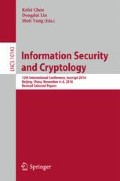Abstract
Tamper resilient cryptography has recently gained attention, and novel coding solutions have been proposed. One such solutions is Tamper Detection (TD) codes that are used to detect tampering with a codeword when the tampering function belongs to a specified family of functions. We consider TD codes when the class of functions consists of functions where the adversary first selects a subset of size \(\rho n\) of the codeword components to see, and then uses this view to choose a noise vector that will be added (algebraically) to the codeword (n is the codeword length). We show it is impossible to construct codes that protect against tampering of all functions in this class. By removing the set of bad functions from the class, we obtain a subset of this family for which tamper detection codes exist, and give a construction of tamper detection codes for this subset. We discuss our results and directions for future work.
Access this chapter
Tax calculation will be finalised at checkout
Purchases are for personal use only
References
Shannon, C.E.: A mathematical theory of communication. Bell Syst. Techn. J. 27, 379–423, 623–656 (1948)
Cheraghchi, M., Didier, F., Shokrollahi, A.: Invertible extractors and wiretap protocols. IEEE Trans. Inf. Theory 58(2), 1254–1274 (2012)
Aggarwal, D., Dodis, Y., Lovett, S.: Non-malleable codes from additive combinatorics. In Shmoys, D.B. (ed.) 46th ACM STOC, pp. 774–783. ACM Press, New York, 31 May–3 June 2014
Lin, F., Safavi-Naini, R., Wang, P.: Detecting algebraic manipulation in leaky storage systems. In: Nascimento, A.C.A., Barreto, P. (eds.) ICITS 2016. LNCS, vol. 10015, pp. 129–150. Springer, Cham (2016). doi:10.1007/978-3-319-49175-2_7
Simmons, G.J.: Authentication theory/coding theory. In: Blakley, G.R., Chaum, D. (eds.) CRYPTO 1984. LNCS, vol. 196, pp. 411–431. Springer, Heidelberg (1985). doi:10.1007/3-540-39568-7_32
Ahmadi, H., Safavi-Naini, R.: Detection of algebraic manipulation in the presence of leakage. In: Padró, C. (ed.) ICITS 2013. LNCS, vol. 8317, pp. 238–258. Springer, Cham (2014). doi:10.1007/978-3-319-04268-8_14
Jafargholi, Z., Wichs, D.: Tamper detection and continuous non-malleable codes. In: Dodis, Y., Nielsen, J.B. (eds.) TCC 2015. LNCS, vol. 9014, pp. 451–480. Springer, Heidelberg (2015). doi:10.1007/978-3-662-46494-6_19
Jafargholi, Z., Wichs, D.: Tamper Detection and Continuous Non-malleable Codes [full version] (2015). http://eprint.iacr.org/2014/956
Cheraghchi, M., Guruswami, V.: Capacity of non-malleable codes. In: Naor, M. (ed.) ITCS 2014, pp. 155–168. ACM, Princeton, 12–14 January 2014
Cheraghchi, M., Guruswami, V.: Non-malleable coding against bit-wise and split-state tampering. In: Lindell, Y. (ed.) TCC 2014. LNCS, vol. 8349, pp. 440–464. Springer, Heidelberg (2014). doi:10.1007/978-3-642-54242-8_19
Langberg, M.: Oblivious communication channels and their capacity. IEEE Trans. Inf. Theory 54(1), 424–429 (2008)
Ozarow, L.H., Wyner, A.D.: Wire-tap channel II. At & T Bell Lab. Techn. J. 63(10), 2135–2157 (1984)
Wang, P., Safavi-Naini, R., Lin, F.: Erasure adversarial wiretap channels. In: 53rd Annual Allerton Conference on Communication, Control, and Computing (2015)
Wang, P., Safavi-Naini, R.: Limited view adversary codes: bounds, constructions and applications. In: ICITS 2015, pp. 214–235 (2015)
Wang, P., Safavi-Naini, R.: A model for adversarial wiretap channels. IEEE Trans. Inf. Theory 62(2) (2016)
Faust, S., Mukherjee, P., Venturi, D., Wichs, D.: Efficient non-malleable codes and key-derivation for poly-size tampering circuits. In: Nguyen, P.Q., Oswald, E. (eds.) EUROCRYPT 2014. LNCS, vol. 8441, pp. 111–128. Springer, Heidelberg (2014). doi:10.1007/978-3-642-55220-5_7
Safavi-Naini, R., Wang, P.: Codes for limited view adversarial channels. In: IEEE International Symposium on Information Theory (ISIT), pp. 266–270 (2013)
Hamming, R.W.: Error detecting and error correcting codes. Bell Syst. Techn. J. 29, 147–160 (1950)
Cramer, R., Dodis, Y., Fehr, S., Padró, C., Wichs, D.: Detection of algebraic manipulation with applications to robust secret sharing and fuzzy extractors. In: Smart, N. (ed.) EUROCRYPT 2008. LNCS, vol. 4965, pp. 471–488. Springer, Heidelberg (2008). doi:10.1007/978-3-540-78967-3_27
Dziembowski, S., Pietrzak, K., Wichs, D.: Non-malleable codes. In: ICS, pp. 434–452 (2010)
Dziembowski, S., Kazana, T., Obremski, M.: Non-malleable codes from two-source extractors. In: Canetti, R., Garay, J.A. (eds.) CRYPTO 2013. LNCS, vol. 8043, pp. 239–257. Springer, Heidelberg (2013). doi:10.1007/978-3-642-40084-1_14
Guruswami, V., Smith, A.: Codes for computationally simple channels: explicit constructions with optimal rate. In: FOCS, pp. 723–732 (2010)
Author information
Authors and Affiliations
Corresponding author
Editor information
Editors and Affiliations
Rights and permissions
Copyright information
© 2017 Springer International Publishing AG
About this paper
Cite this paper
Lin, F., Safavi-Naini, R., Wang, P. (2017). Codes for Detection of Limited View Algebraic Tampering. In: Chen, K., Lin, D., Yung, M. (eds) Information Security and Cryptology. Inscrypt 2016. Lecture Notes in Computer Science(), vol 10143. Springer, Cham. https://doi.org/10.1007/978-3-319-54705-3_19
Download citation
DOI: https://doi.org/10.1007/978-3-319-54705-3_19
Published:
Publisher Name: Springer, Cham
Print ISBN: 978-3-319-54704-6
Online ISBN: 978-3-319-54705-3
eBook Packages: Computer ScienceComputer Science (R0)

